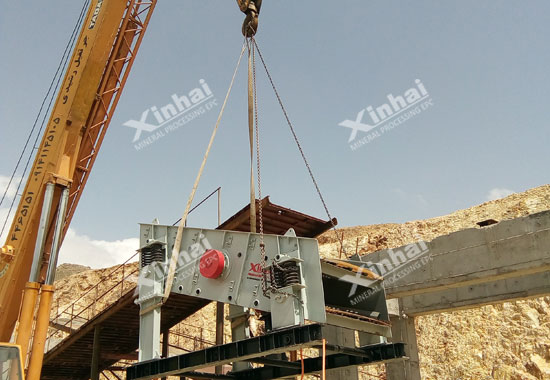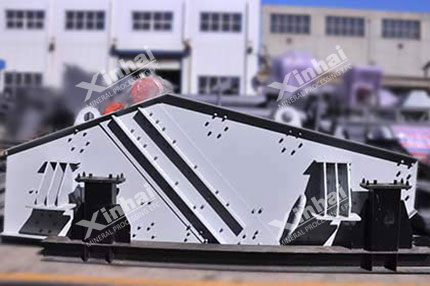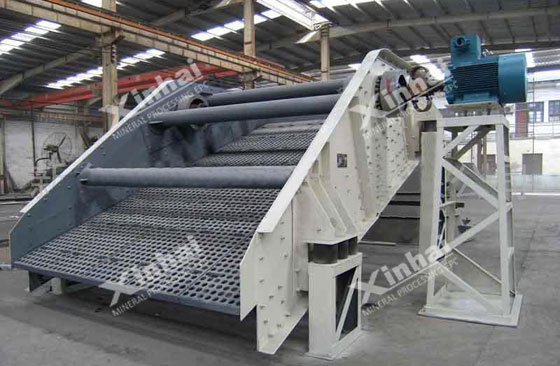The Screening Efficiency of Vibrating Screen is Too Low? Are These Five Performance Parameters Correct?

In the mineral processing production, many mine owners may have met various problems, like the vibrating screen cannot reach the expected processing capacity, the screening efficiency is too low. As an important screening equipment, the screening efficiency of vibrating screen will directly affect the final product quality and investment cost.
Generally, the screening efficiency of vibrating screen is related to many factors, such as material properties, equipment structure and various performance parameters. In addition to the hard factors of material properties and equipment structure, we mainly start from the performance parameters and analyze the influence of each performance parameters on the screening efficiency of vibrating screen, including amplitude, vibration frequency, vibration direction angle, screen surface inclination angle and projectile angle, so as to provide reference for vibrating screen operators.
1. Amplitude of vibrating screen
Generally, the larger model the vibrating screen , the larger the selected amplitude. If the amplitude of the vibrating screen is larger, the phenomenon of screen hole blockage will be less, which is more conducive to the screening of ore stratification, and obtain better screening production capacity. However, it should be noted that if the amplitude of the vibrating screen is too large, the strong vibration will cause relatively large damage to the vibrating screen itself. The vibration screen amplitude selection is usually determined by the ore size and properties, when the ore particles are small, wet and also have a certain viscosity, we need to use low frequency, large amplitude.
In addition, the corresponding amplitudes and frequencies should be selected for different screening stages. For example, the screening operations used before the separation generally use low frequency, large amplitude of vibration, dehydration, the deintermediation operations generally uses high frequency, small amplitude.

2. Vibration frequency of vibrating screen
The vibration frequency has direct influence on the pulsation state of ore particles on the screen surface. Taking high frequency vibrating screen as an example, its high frequency can well break the tension of pulp surface, makes fine material oscillate at high speed on the screen surface, accelerates the separation of useful minerals, and increases the probability of contact between material with less than separated particle size and sieve hole, thus creating good screening conditions. Too high or too low vibration frequency is not beneficial to screening efficiency vibrating screen.
According to the study, no matter what screening operation the vibrating screen carries out, the vibration frequency is maintained at 850-1000 times/minute as an ideal choice. If the frequency is too low and the vibration intensity is the same, the weight of the eccentric block of the vibrator will increase accordingly, which is not economical enough. At the same vibration intensity, the higher frequency will greatly affect the running speed of the ore, which means that the processing capacity is reduced. Therefore, the vibration frequency is not adjusted at will, must be adjusted to the appropriate range according to the actual situation of the selection plant to make the vibrating screen play the ideal performance.

3. Slope angle of screen surface
Slope angle of screen surface refers to the included angle between screen surface and horizontal plane. The size of its angle is closely related to the processing capacity and screening efficiency of the vibrating screen. When the inclination angle of the screen surface increases, the movement speed of ore particles on the screen surface becomes faster, and the processing capacity increases accordingly. However, the residence time of ore particles on the screen surface is correspondingly shorter at the same time, which affects the screening efficiency of the vibrating screen.
The slope angle of screen surface is determined according to the material application and actual production needs. Horizontal vibrating screen is recommended for fine screening. If the granularity of screening material is large and the screening rate is good, the slope angle can adopt 5-10°. If the particles are large and overgrinding, the slope angle can adopt 15°. The reasonable range of slope angle is based on the uniform distribution of material particles. Installation inclination of different types of vibrating screen is different, the installation inclination of high frequency vibrating screen is about 30°, the inclination of vibrating screen used for the general purpose is 0-15°.

4. Vibrating direction angle of vibrating screen
The vibration direction angle mentioned here refers to the included angle between the screen motion direction and the screen surface, which is generally denoted by β. When determining the vibrating direction angle, the first thing should be considered is the nature of the ore being screened. For the ore with high density or fine particle size, easy to be crushed, the vibrating direction angle of vibrating screen should be large. For those minerals with large water content, strong viscosity or abrasion resistance, the vibrating direction angle of vibrating screen should be small.
In actual production, most linear vibrating screen adopt the vibrating direction angle as 30°, 45° and 60°, which can not only better adapt to various screening performance, but also obtain the best moving speed and screening efficiency. The vibrating direction angle of the circular vibrating screen is 90°, so the circular vibrating screen needs to be installed at an angle, otherwise the minerals will not move forward.

5. Projection angle of vibrating screen
According to the screening theory and practice, the size and strength of the projection angle of vibrating screen have direct influence on the screening of the ore on the screen surface. When the projection strength of vibrating screen of ore increases, the inertial force is also larger, the ore can be thrown higher, which is more conducive to the screening. However, too much projection strength will inevitably affect the screen box, making it premature damage. Therefore, the size and strength of the projection angle should consider the structural strength of the screen box.
In the actual use of the process, different types of vibrating screen will certainly have some differences. It is suggested that all mine owners look for equipment manufacturers with the qualification of mineral processing EPC+M+O service to purchase the appropriate vibrating screen, and determine the value of each parameter according to the actual situation of the mineral processing plant, so as to obtain the ideal screening efficiency of the vibrating screen.




